
2015.2 | 2015.1 | 2014.2 | 2014.1
2013.2 | 2013.1 | 2012.2 | 2012.1 | 2011.2 | 2011.1 | 2010.2 | 2010.1
2009.2 | 2009.1 | 2008.2 | 2008.1 | 2007.2 | 2007.1 | 2006
August – December 2013 (published bimonthly)
- December Newsletter – December 3
- October Newsletter – October 2
- August Newsletter – August 1
December 2013 Newsletter
 |
| Anthony Bourdain entertaining newfound friends in a Paris bistro. |
Shows and Conferences
Pala International News
- Pala’s Featured Mineral Specimen
- Pala National: Mia Dixon waves the red, white and blue
- Roll Away the Stone
Mineral and Mineralogy News
Pala Presents
Recycle Bin
Shows and Conferences
Tucson Time: February 4–16, 2014
After the holidays, we’re looking forward to the world’s greatest gem and mineral show in February. One-stop general information about individual shows can be obtained from the Tucson EZ-Guide.
Pala International will be represented in Tucson as follows. We look forward to seeing our many friends there. Visit the Pala International Show Schedule for future events.
AGTA GemFair
 |
Pala joins nearly 100 exhibitors for this trade-only annual extravaganza.
Event: AGTA GemFair
When: February 4–9, 2014
Where: Tucson Convention Center
Pala International Booth: 1016
The event website now features an interactive floorplan allowing you to see who is exhibiting by area of the convention center.
Free seminars by notables in the world of gemstones and pearls will be listed shortly. Special exhibits this year include
- Displays of the Spectrum Awards winners for gem and jewelry design as well as the finalists of the International Pearl Competition
- The “Magical Gifts of Nature” a new traveling exhibition of Extraordinary and Incredible Cultured and Natural Pearls
- Highlights of the Smithsonian Institution’s Janet Annenberg Hooker Hall of Geology, Gems & Minerals
- Somewhere In The Rainbow – A Modern Gem and Jewelry Collection
13th Annual Westward Look Mineral Show
Pala International and two dozen other world-class mineral dealers shack up at a Sonoran Desert resort.
 |
- Collector Day (Sat) features Al and Sue Liebetrau and selections from their private collection
- The Pederneira Mine – A Rainbow of Colors (Sun) features Daniel Trinchillo
Event: 13th Annual Westward Look Mineral Show
When: February 7–10, 2014
Where: Westward Look Resort
Pala International Suite: 224, Building 20, Upper Level
See Pala International’s page on the Westward Look Show site. See also this dealer map.
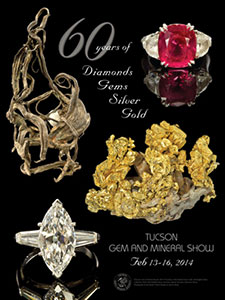 |
60th Annual Tucson Gem and Mineral Show
TGMS is the largest gem and mineral show in the country. This year’s theme is “60 Years of Diamonds, Gems, Silver and Gold.”
Event: 60th Annual Tucson Gem and Mineral Show
When: February 13–16, 2014
Where: Tucson Convention Center
Pala International Booth: Aisle 5 East
[back to top]
Tucson Transit Tips
Many shows will offer their own shuttles. View your transit and parking options here. [back to top]
An American in Paris
As we were brining our bird, chez Hughes, anticipating the discerning palates of brother Richard, sister-woman Wimon Manorotkul, and niece E. Billie, in Denver for a red-shirt respite, Pala International’s Bill Larson was preparing to fly to La Ville-Lumière—Paris—visiting No. 2 son Carl, who has been examining the collection of René Just Haüy at the Muséum national d’Histoire naturelle. While Bill might have missed a chance at the wishbone, he did get his wish: the opportunity to catch the Paris International Mineral Show, which was held November 29 through December 1. Here are some of the sights seen.
 |
| Marché–maison. Ah, the life of a struggling célibataire in Paris. With Algerian dates going for €10 to the kilo, Carl Larson opts for a simple Thanksgiving spread of rice, roasted pommes de terre, épinards mignons, and a bottle of Beaujolais-Villages—by candlelight. (Photos: Bill Larson) |
 |
 |
| Get crackin’. Dining out is a different story, as plateaux de fruits de la mer beckon. (Photo: Bill Larson) |
 |
| Copping a feel. Alain Martaud, left, chooses copped minerals from the Muséum d’Histoire naturelle with Jon Marc for the Sainte-Marie-aux-Mines show next year. (Photo: Bill Larson) |
 |
| Sleeping beauties. Statuary and such under wraps at the museum. (Photo: Bill Larson) |
 |
| Ooh-la-la! Olivier Segura, director of the Laboratoire Français de Gemmologie, examines the 135-carat Louis XIV sapphire that Carl Larson is researching at the museum. (Photo: Bill Larson) |
 |
| Cobalto calcite specimen from the Congo at the Paris International Mineral Show at l’Espace Charenton on Saturday. (Photo: Carl Larson) |
 |
| Working the room. Carl Larson, above left, and Alain Martaud at the Alain Martaud Minéraux booth, Paris International Mineral Show on Saturday. Below, several specimens from Alain’s case, including a crystallized gold from the Bright Star Mine, Colorado. Click to enlarge. (Photos: Bill Larson, Carl Larson) |
 |
 |
| Découpage. Dendritic mineral growth in oval slices at the Paris International Mineral Show, offered by Indian dealer Tarun Adlakha. See Richard Wise’s blog for an overview of Adlakha’s technique. (Photo: Carl Larson) |
 |
| Answering machine. Jean-Claude Boulliard takes a break from the constant mineral questions he receives as curator of the Sorbonne. (Photo: Bill Larson) |
 |
| Bibliophilia. Books also are offered at the Paris show. Below, an image of a Boer farmer from a book dealing with colonization of southern Africa. (Photos: Bill Larson, Carl Larson) |
 |
[back to top]
Pala International News
Pala’s Featured Specimen: Makalu Quartz
This month we feature a stunning quartz cluster from Nepal.
This eloquent assemblage of quartz shows the best from Nepal: sharp, clear and pristine crystals. To top it all off is a superb Japan-law twin perched right in the center of this complex specimen. One side of the twin actually penetrates the largest vertical crystal. Compounding beauty and rarity.
 |
| Makalu Quartz from Sankhuwasabha District, Kosi Zone, Nepal, 11.5 x 5 x 5.5 cm. Price available upon request. Click to enlarge. (Photo: Mia Dixon) |
This unique specimen is from a quartz mine in the Makalu Mountain area, somewhere between Gunyahang and Sabhapokhari Mountain. Also referred to as Jaljale Himal, Sankhuwasabha district, Eastern Nepal. This deposit lies at 12,175 feet and requires climbing a pass that reaches 14,500 feet.
Interested? Select the inventory number above, call or email us to inquire.
 |
[back to top]
Pala National
Mia Dixon waves the red, white and blue
Two weeks ago, Mia Dixon, Pala International’s resident photographer became more than a permanent resident of the USA. Mia, a native of Sweden, became an American citizen as she gave the Oath of Allegiance.
Congratulations, Mia!
 |
| All doc-ed out. On the other side of the camera, for once, Pala International’s Mia Dixon stands with documentation of her citizenship. |
 |
| Trading glögg for nog? Mia Dixon was congratulated by Pala people with a red, white and blue bouquet, upon receiving American citizenship. |
 |
[back to top]
Roll Away the Stone
Bill Larson received his own congratulations when, not long before Thanksgiving, he experienced his own Easter. It seems that while he was driving to the West Coast Gem & Mineral Show in Santa Ana, word of his demise had been posted online by a somewhat disoriented V.H.
We lost a true Icon of our Industry when we lost Bill Larson.. RIP http://www.store.palagems.com/burma2013.htm
Bill Larson in Burma 2013
www.store.palagems.com
Bill Larson travels to Burma and the Mogok Valley.
Dealer Rick Kennedy saw the post and collector Jon Sigerman tried to call, but Bill was on the 15. “When I showed up at the show,” he told us, “five people were relieved I was alive.” He quickly added, “Probably more were sad I wasn’t dead.” And, yes, he got some mail…
 |
 |
[back to top]
Mineral and Mineralogy News
Rubies from Montepuez
Vincent Pardieu has been writing about rubies from northern Mozambique for years. In the fall of 2008, he received word from his friend and Tanzanian gem dealer, Abdul Msellem, about new rubies being traded at a market near Winza. They were sourced in Niassa Province, Mozambique, and Pardieu was able to access them in Chantaburi, Thailand. By March 2009 he had released a report on the material via GIA Bangkok, where he manages the Field Gemology Department. The stones were lusciously red and pink, and six months later he visited the locality.
 |
| Vincent Pardieu with a selection from Carl and Bill Larson’s fruits de la mer. (Photo: Richard W. Hughes, 2009, Pemba, Mozambique) |
Five years later, Pardieu has tied together various field reports and G&G Gem News International items into an 80-page study on another ruby-producing locality in the region—Montepuez. In “Rubies from the Montepuez Area (Mozambique),” he and coauthors Supharart Sangsawong, Jonathan Muyal, Boris Chauviré, Laurent Massi, and Nicholas Sturman cover the following.
- Location and access
- Geology – this section should be of interest to mineralogists
- Description of the rough
- Materials and methods, including sample fabrication and instrumentation
- Nearly twenty pages of studies of reference samples, including trace element variations between the localities various mines
- Inclusions and conclusions
- Bibliography
Since its discovery, during the spring of 2009, rubies from Montepuez have dominated Thailand’s ruby trade. And Thailand dominates the world’s ruby trade. And this study likely dominates the discussion of its subject. We’ll wager that mineral enthusiasts wouldn’t mind having a 40-gram specimen like the one Pardieu snapped back in 2009. [back to top]
Animal Mineral Vegetable
Residents of, and visitors to, Southern California may at one point have encountered the phenomenon of the Salton Sea, essentially a mistake of engineering and Mother Nature. The “sea” was accidentally created in 1905, then turned into a resort, finally abandoned after hurricanes, floods and fish die-offs. (At a screening of the film documentary Plagues and Pleasures of the Salton Sea, co-director Chris Metzler told me his next projects were to be docs on opal miners of Australia and gay big-rig drivers.)
Whereas the Salton Sea is purdy darn salty, its salinity can’t compare with the chemical stew of northern Tanzania’s Lake Natron, named for a compound of sodium carbonate and sodium bicarbonate. Only two species of alkaline tilapia can survive the lake’s waters. Other wildlife perish when immersed in the lake—and become calcified. Paradoxically, the lesser flamingo thrives in the lake’s vicinity since its predators are thwarted by the environment.
 |
Not only do birds and bats falter by the lake’s waters, they become calcified, as can be seen in the photography of Nick Brandt. Brandt came to East Africa via rock video, having shot Michael Jackson’s “Earth Song” in 1995. (Director Metzler also has an interest in music, co-directing Everyday Sunshine: The Story of Fishbone—yes, Fishbone.) Since that time, Brandt has issued a trilogy of still-photography collections that capture the fleeting fauna of the region.
See New Scientist for more on this mysterious petrification phenomenon [back to top]
Red Rods and Disco Balls
 |
Poland’s Geological Society “Spirifer” has released Issue 7 of its Minerals: The Collector’s Newsletter. In this issue:
- The brilliantly red crocoites of Tasmania’s Red Lead Mine
- The “disco balls” (apophyllite) of Rahuri, India
- The photography of Jeff Scovil
- A profile of collector Bruce Cairncross
- A look at the journal Rocks & Minerals
Also on the Spirifer website are travelogues for Sieland, Norway; Madan, Bulgaria; and Morocco. [back to top]
Crust Removed
 |
| An ancient meteorite (“NWA 7533”) appears to be a piece of Martian crust. (Image courtesy Luc Labenne) |
A researcher at the National High Magnetic Field Laboratory (MagLab) has determined that a meteorite may hold the key to the Martian crust.
Florida State University Professor Munir Hamayun and colleagues have analyzed a 4.4 billion-year-old Martian meteorite from the Sahara Desert, which was unearthed by Bedouins. The analysis indicates that Mars had a “warm, wet dawn,” according to a Christian Science Monitor overview of a study published November 20 by Humayun et al. in Nature.
The meteorite is described as being “one-of-a-kind” and a “once-in-a-lifetime find” because, unlike other Martian meteorites, this one is the first example of Martian breccia, or a rock composed of joined fragments—in this case containing at least six types of igneous rock as well as apparent sedimentary rocks. [back to top]
Pala Presents
Gem- and Lithium-Bearing Pegmatites of the Pala District
Part 2: Pegmatites
With Pala Presents, we offer selections from the library of Pala International’s Bill Larson, who will share with us some of the wealth of information in the realm of minerals and mineralogy.
This study of the pegmatites of the Pala district was conducted in the late 1940s by Richard Jahns and Lauren Wright. A total of 39 weeks of field work was done between the two researchers. The project examined more than 350 pegmatite dikes; four of those were mapped, one of which in detail for more than half a mile of its entire exposed length. Sixteen mines were mapped and a hundred more mines and prospects visited and studied. A monumental undertaking.
In part two of our offering, “Pegmatites,” the following major topics are covered.
- Distribution and occurrence
- General structural features
- Principal types of pegmatite
- Internal structure
- Mineralogy
- Origin of the pegmatites
Although the text is quite dense, the study’s tables provide easily accessible high-level particulars about the pegmatites. Table 2 displays information according to mountain name, providing pegmatite dike or dike group, mine and/or prospect names, and principal output. Table 3 is a sort of cross-reference providing the data grouped by mineral. Table 4 looks at the general age-abundance relations of principal minerals in the Pala pegmatites.
 |
| Section through west tunnel, North Star mine, showing tapered edge of pegmatite dike in gabbro and quartz-mica schist. |
[back to top]
Recycle Bin
We offer two items from our sibling e-publication, Palagems Reflective Index, of interest to mineral specimen enthusiasts.
Munich Show in Pictures
The Munich Show was held October 25–27 this year. Pala International shared selling space with Alain Martaud Minéraux as well as display space with “Gold,” this year’s special exhibition. Pala’s contribution was the “Christmas Tree,” one of the finest gold specimens in the world. The specimen will be included in the forthcoming book, Gold for Collectors, by Joaquim Callén and Eloisa Artola.
See more photos here.
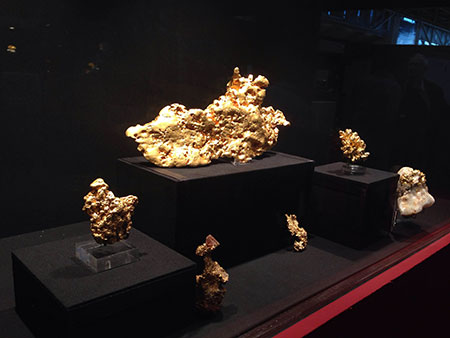 |
| “Gold” was this year’s special exhibit at the Munich Show. Above, some examples of the fine specimens displayed. Below, Pala International’s Will Larson nearly pops a stitch as he holds the “Ausrox Gold Nugget”—although “nugget” seems a bit of an understatement for the world’s third largest, at 23.26 kg, 22 x 24 x 16 cm. (Photos: Carl Larson) |
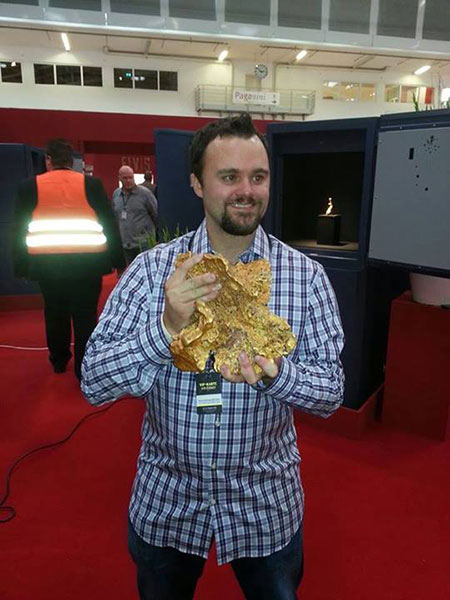 |
[back to top]
MIM’s the Word
A new museum opened in Beirut, Lebanon on October 12: the Museum of Minerals, aka MIM. The museum was conceived by Salim Eddé, Murex software cofounder, and assisted by the Jesuit University. It’s being compared with other world class museums. Read about it here.
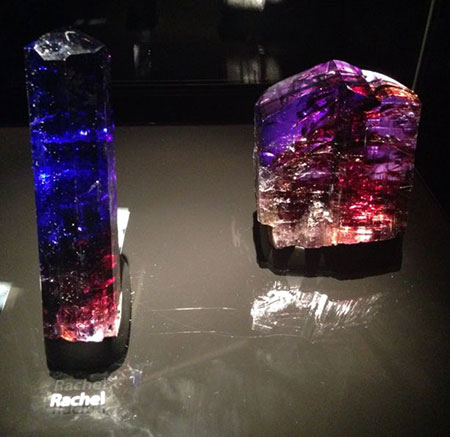 |
| But of course, “Rachel.” This image was sent to us by Dr. Raquel Alonso-Perez, curator of the Mineralogical and Geological Museum at Harvard University. See this overview of the museum and its opening by Dr. Eloïse Gaillou, Associate Curator at the Natural History Museum of Los Angeles County. And a streaming video tour, below. |
 |
[back to top]
Changsha: Let a Thousand Museums Bloom
Extensive coverage from Peter Megaw and Allison Megaw
in Rocks & Minerals
The policy of letting a hundred flowers bloom and a hundred schools of thought contend is designed to promote the flourishing of the arts and the progress of science….
—Mao Zedong, On the Current Handling of
Contradictions Among the People, 1957
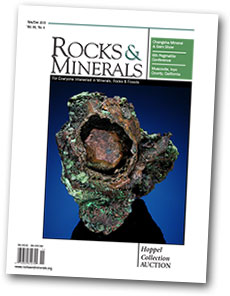 |
Dr. Peter Megaw and Allison Megaw traveled to Hunan Province in May for the First China (Changsha) Mineral and Gem Show (CMGS), not as visitors, but as guests to advise the show organizers on their exhibits. In addition to being a geologist, mineral collector, and author, Peter has long been exhibits chair for the Tucson Gem and Mineral Show™. As the Megaws write in the November–December 2013 edition of Rocks & Minerals (88:6, 502–515; abstract here), “we headed over to what was being billed as the ‘Oriental Tucson Show’ to see whether it was possible to build a Tucson- or Munich-scale show essentially overnight.” The show was held May 15 through May 20.
Changsha, in the northeastern part of eastern China’s Hunan province, may not have been a destination for many of our readers, but you might already have visited it in a virtual sense: as the authors point out, “the bizarre rock pillars” of the nearby Zhangjiajie National Forest Park were inspiration for some of the scenery in James Cameron’s 2009 blockbuster film, Avatar. If you saw the film in 3-D, you felt like you were there, but your other senses were grateful for the omission of Changsha’s 30+°C temperature and 75% humidity. While Changsha was foreign to the Megaws, who hadn’t yet visited China, it also was familiar in the sense of being yet another big city. Adding to the familiarity, at the show, was the fact that that the international dealers, with their well-known faces, were positioned at the CMGS first-floor entrance.
 |
| Huge manganese-rich twinned calcite crystals on pale green fluorite from Manaoshan mine, Chenzhou City, Hunan Province. It appeared to the article’s authors that 1 meter was the minimum target dimension amongst Chinese collectors. The largest calcite above is 30 cm across; overall the specimen is 180 × 150 cm. Dealer stock. (Photo: Peter Megaw) |
Set-up, as recounted by Pala International’s Will Larson (“Chowing Down in Changsha”), was hampered by merchandise trickling ever so slowly through customs. The Megaws include a photo in their article of Wayne Leicht and Lois Nelson in front of their completely empty Kristalle–Crystal Classics booth on set-up day. Nerves were somewhat eased that evening by the welcoming banquet, although a dish labeled “bacteria chicken” might have given one pause.
The theme of this year’s inaugural show was “Mineral Museums,” and the authors note that this was not an ethereal conceit that evaporated on May 21: over the next ten years, the Chinese government is putting its organizational and financial weight behind more than a thousand new natural science museums focused on geology-mineralogy and fossils. (Okay, collectors, start dusting off your seconds!) Many representatives of world-class museums were in attendance, and when they weren’t involved in the forums they might have been turning a shade of tsavorite, envious of what a government giveaway might do.
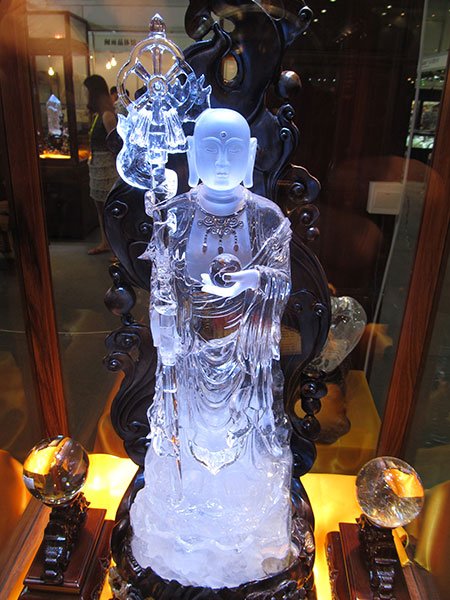 |
| Carving of Buddha made from a single quartz crystal, 120 cm tall. Dealer stock. (Photo: Peter Megaw) |
The authors continue by discussing the nature of the CMGS conference presentations and posters, and the exhibition itself, in some helpful detail. They also provide a lengthy critique of the show, including the differences between Chinese collecting practices and those of the West, and how they foresee a different sort of show in 2014, not only because its theme will be “Mining.” Although their article is slanted towards the mineral specimen collector, anyone interested in the burgeoning China market for minerals and gems would benefit from the information—both textual and visual. Back issues are available at Rocks & Minerals. [back to top]
— End December Newsletter • Published 12/3/13 —
October 2013 Newsletter
 |
| From Mogok with Love. Pala International’s Bill Larson sent this yesterday. (Click to enlarge.) For details of one of his travel highlights, see this story in our sibling e-newsletter, Palagems Reflective Index. |
Shows and Conferences
- Mineralientage München 50th Munich Mineral Show October 25–27, 2013
- An Early Christmas at the Munich Show
Pala International News
Mineral and Mineralogy News
Pala Presents
Recycle Bin
Shows and Conferences
Mineralientage München 50th Munich Mineral Show
October 25–27, 2013
Pala International will be selling and exhibiting
 |
Pala International will be sharing space with Alain Martaud at this year’s Munich Show.
When: October 25–27, 2013
Where: Munich Trade Fair Centre
Hours:
Friday, October 25: 9:00 AM – 7:00 PM (Trade only)
Saturday, October 26: 9:00 AM – 7:00 PM
Sunday, October 27: 9:00 AM – 6:00 PM
Booth: International Mineral Pavilion, Hall A6; look for Alain Martaud Minéraux
This year’s special exhibit—in honor of the show’s jubilee year—is titled “Gold.” It will feature the “Ausrox Gold Nugget” (world’s third biggest, 23.26 kg, 22 x 24 x 16 cm), “Screaming Man” (from Kurnalpi in Western Australia, 20.32 x 7.62 x 5.08 cm), and “Camel” (shown below). This exhibit will be covered in the Theme Book, a high-quality hardcover, which will include the show catalog. Available from the show store.
 |
| Camel. This nugget was found in Widgiemootha, Western Australia, and is in private hands. It measures 7 cm high, 16.5 cm wide and 10.16 cm deep. (Photo courtesy Intragenerational Henchmen) |
As usual, there are many activities for the junior set, such as gemstone faceting, but another activity is available to children of all ages—if you are visually impaired, that is. The “Comprehending Stones” exhibit, presented by Mr. and Mrs. Schwinghammer, is hands-on, “from the edgy surface of a pyrite to the soft texture of a soapstone.”
For more information visit the show website. See the Pala International Show Schedule for future events. [back to top]
An Early Christmas at the Munich Show
Exhibited Pala Specimen Has History
 |
The special exhibition at this year’s Munich Show, “Gold”: The Jubilee’s Show will feature specimens anthropomorphic (“Screaming Man”) and zoomorphic (“Camel”). But the biomorphic also will be represented, as in “Christmas Tree,” courtesy of Pala International. It is one of the finest gold specimens in the world.
 |
| Gold on gold. The metallic gold ink of the catalogue cover is echoed, faintly, by the aging paper on which it is printed. |
The specimen is featured in an 1886 catalogue for the sale of the collection of one A. Dohrmann, Esq. The auction was catalogued and conducted by the firm of S. H. and H. Chapman. The collection’s owner, Adolph Dohrmann (1832–1886), is profiled by Wendell Wilson of Mineralogical Record. Dohrmann, a native of Germany, emigrated to the U.S. in the early 1850s, being employed in the grocery business in Stockton, eventually becoming a proprietor. Later, in San Francisco, he went into the business of milling grain.
Along the way, Dohrmann collected nearly 2,000 specimens of gold, silver and more. Upon his death, on October 24, 1886, his family sought the services of the numismatic firm of S. H. & H. Chapman, in Philadelphia. According to an American Numismatic Society profile of the Chapmans, the brothers began work as teenagers with coin dealer John W. Haseltine. Before dissolving their partnership in 1906 they had held 83 auctions, including that for the Dohrmann collection.
 |
| Above, a photographic image of the “Christmas Tree” specimen in the 1886 catalogue. The technology of photography was revolutionized by George Eastman with the first “film” being produced on paper strips in the early 1880s. Film as we know it (or knew it) was introduced in 1889. This image captures beautifully the cascading structure of the specimen’s upper-right face. It was S. H. Chapman whose fine photography graced the company’s catalogs. According to an inventory of the Chapman collection, as late as the mid-1910s, S. H. still employed glass plates. Below, the catalogue description for the pictured specimen. (Images courtesy Bill Larson, Pala International) |
 |
As Lawrence Conklin wrote in his “Anatomy of a Mineral Sale: The Dohrmann Collection” (Mineralogical Record, 23, 7–13), the Dohrmann sale was “one of the few significant auction sales of mineral specimens to take place in America.” It took place mid-December 1886 at the Davis & Harvey Art Gallery in Philadelphia. (Conklin notes that Dohrmann himself appears to have sold an important coin collection in 1882.) Conklin’s “anatomy” of the sale was facilitated by having access to the auction’s “bid book,” in which is contained bids, of course, but also estimates, realized prices, reserve prices and names of the purchasers (including G. F. Kunz, who by no means broke the bank at Tiffany & Co.).
The collection contained 1,687 mineral specimens, 105 gemstones, 98 fossils and 9 Indian stone implements. Of the 372 golds, the “Christmas Tree” was obtained at the auction by the American Museum of Natural History. The museum traded it to Pala International’s Bill Larson in the 1970s. Interestingly, it was part of a major exchange, and the specimen was not identified as matching No. 60 from the Dohrmann sale until Lawrence Conklin recognized it. The specimen received its arboreal appellation by the late, legendary Ed McDole, who called it his favorite mineral specimen. Bill Metropolis, who for decades was curatorial assistant at the Mineralogical & Geological Museum at Harvard University (MGMH), wrote the specimen up for a Stack’s auction catalogue, reproduced below.
 |
| An excerpt of the description of Lot 2083, Native Gold Crystal, mentioning the “Christmas Tree” specimen, “similar in shape” to the offered crystal. From the the catalogue for the sale of The Roraima Shield Collection conducted by Stack’s, August 5, 2007, in Milwaukee. That collection, amassed by Roger LaRochelle and Jack Carlson, was described by Bill Metropolis as “what is believed to be the finest collection of gold crystals ever formed.” |
The largest single purchaser of golds at the 1886 sale was Georges de la Bouglise (1842–1911), a French mining engineer. His collection found its way to MGMH in 1948 via purchase in 1911 by attorney-turned-entrepreneur Albert Burrage (1859–1931). One gold specimen from the Burrage bequest is a companion to the “Christmas Tree,” hailing from the same Grit Mine in California’s El Dorado County. It is Figure 4 in Conklin’s “Anatomy,” and was No. 61 in the Dohrmann sale catalogue:
Crystals, modified, with one perfect on an extended branch; surface, reticulated; radiating from a median line like the specimen above [the “Christmas Tree,” No. 60]. 27 x 16 x 6. Wt., 278 ½ gr. Same mine [Grit Mine, near Spanish Dry Diggins, El Dorado County]. Like above, it is very beautiful and excessively rare.
This specimen passed through Bill Larson’s covetous fingers this summer when he conducted the appraisal of the mineral collection at MGMH. We had thought these specimens might have been “separated at birth.” Theresa Smith, Curatorial Assistant at MGMH, tells us, “We are not bringing it to Munich, so the sibling pieces will remain forever separate.”
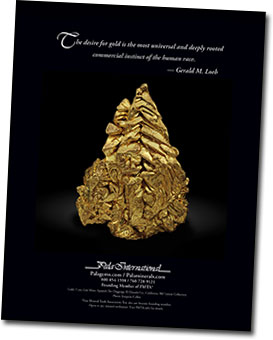 |
| See our ad in this year’s program. This “Christmas Tree” gold specimen will be displayed as part of the Munich Show’s special exhibit, “Gold.” |
[back to top]
Pala International News
Pala’s Featured Specimen: Dioptase from Namibia
This month’s featured mineral is your chance to pick up a rare and hard-to-find specimen that has beautiful green crystals of dioptase sitting on white calcite. The dioptase is damage-free with top luster and it is also a great cabinet size.
 |
| Dioptase from the Tsumeb Mine, Namibia, measuring 12 x 8.5 x 2.5 cm. Click to enlarge. (Photo: Mia Dixon) |
Dioptase from Tsumeb is regarded as one of the holy grails for mineral collectors. Out of all the locations in the world the stark contrast of the beautiful green crystals sitting on white calcite tends to outdo many dioptases from other localities. Please contact us for any inquiries on this piece as well as price.
Interested? Select the inventory number above, call or email us to inquire. [back to top]
Mineral and Mineralogy News
Slipping and Sliding in Utah
No, we’re not talking about Park City.
A small slide last month at a copper mine in Utah brought our attention to a much larger landslide last April at the same mine. On September 11, nearly five months to the day of an April 10 slide, workers were evacuated at Kennecott Utah Copper’s Bingham Canyon copper mine. The movement was detected before a football-sized section of earth gave way, according to a September 12 story in Salt Lake City’s Deseret News. The mine is just west of Salt Lake City.
 |
| Before and After. Kennecott Utah Copper’s Bingham Canyon Mine, above, on July 20, 2011. Below, on May 2, 2013, after the April 10 landslide. See more dramatic images here. (NASA Earth Observatory images by Jesse Allen and Robert Simmon) |
 |
On April 11, the Deseret News reported on what eventually was determined to be a 165 million-ton displacement of earth, pictured above. The company’s engineers were prepared for the slide, if not its magnitude, having detected movement as early as February. The slide buried about two thirds of the pit’s floor, halted production, and led to layoffs. The mine is a tourist attraction, but its visitor center was closed even prior to the bigger slide, last April, according to an April 2 story by Deseret News. [back to top]
Slow Dancing with Lady Gaga
Crystal cameos in Ms. G’s photos, videos
In early August, singer and performer Lady Gaga preceded the release of a new album by spending time immersed in the Abramović Method, a mind-body awareness technique. According to the website of the Marina Abramović Institute (MAI), “the method helps participants to develop skills for observing long durational performances through a series of exercises and environments designed to increase awareness of their physical and mental experience in the moment.”
The Abramović Method might resonate if one has a taste for, say, the relatively brief time suspensions found in Yoko Ono’s film, Fly, in which the camera follows a housefly moving on a woman’s body, or in the choreography of Rudy Perez (with whom your editor had the honor of working), whose iconic Countdown consists of several minutes of a seated man smoking a cigarette—it is his most powerful work. Perhaps the most profoundly affecting performance I ever experienced came from this same realm of temporal tweaking, by the late Kazuo Ohno, master of the Japanese form known as butoh. In Marriage of Heaven and Earth, Ohno stands before a piano, accompanied by Bach’s famous Prelude No. 1, moving in and out of an overhead spotlight, being born, aging, dying, and ascending in front of your eyes, merely by moving achingly into and out of the light. The effortless rigor with which he executed this work was cultivated by years of preparation.
 |
So, yes, there is indeed a need for techniques to perform—and observe—“long durational performances.” Gaga understands this, evidently. But the twittersphere became clogged with surface rather than substance when she dared to put her body where her mouth is, by appearing in a promotional clip for MAI, upon the launch of a crowd-funding effort for construction of its performance and education center. The clip includes a sequence of Lady Gaga embracing a torso-sized quartz crystal, pictured above, and other crystal imagery. It’s not for the easily shocked, so we won’t link to it. But, lest we get too highfalutin, we will link to a shocking photo, from the same session as the image below.
 |
| Quartz clutch. Did Gaga see the Chanel windows? As an unnamed mineral show organizer told us, “Perhaps the entire country should see this and we could make a few more people interested in mineral specimens!” |
 |
| Lady Gaga’s use of more crystal imagery in the video of “Born This Way,” shown above, was noted by the designer of a (presumably faux) quartz crystal headpiece. |
[back to top]
Iron Stylings from the Sky
Meteorite material finds its way into ancient designs
Turning for a moment from accessories terrestrial, we look at out-of-this-world baubles—from ancient Egypt.
Personal taste and the desirability of a given material varies over time. This is nowhere more evident than in the refined discrimination of ancient Egyptians—those who could afford lapis, carnelian, jasper, quartz crystal, turquoise and malachite. Of course, these were softer and more workable than harder stones; thus even colored glass was employed in Egyptian jewelry designs. But these ancients also held meteorite iron in the same esteem as gold and gemstones, according to authors of a new study.
 |
| Beaten beads. Meteoric iron beads along with other exotic minerals found in grave 67. The ancient Egyptian iron beads are held at the University College London Petrie Museum. They were hammered from pieces of meteorites, rather than terrestrial iron ore. The objects, which trace their origins to outer space, also predate the emergence of iron smelting by two millennia. Click to enlarge and click to see more images. (Photo courtesy UCL Petrie Museum/Rob Eagle) |
In surviving examples of this ancient jewelry, it’s the proximity the iron beads have to the gemstones that prompted a suggestion of value and worth by the authors of “5,000 years old Egyptian iron beads made from hammered meteoritic iron,” available for public reading from the Journal of Archaeological Science.
The iron material—actually a natural alloy of iron and nickel—was carefully shaped by hammering the metal into thin sheets and then rolling them into tubes, according to the study. As early as the fourth millennium C.E. the artisans already had mastered the smithing of this material, which is more brittle and harder than the copper that was more commonly fashioned. The material’s origin was determined by scanning for trace elements that normally are found in higher concentrations than in terrestrial iron ore.
For more information on meteorites in Egypt, as well as the contribution one made to King Tutankhamen’s necklace, visit the UCL Museums & Collections blog. [back to top]
Pala Presents
Gem- and Lithium-Bearing Pegmatites of the Pala District
Part 1: Abstract & Introduction; Physical Features;
Historical Sketch; Geology
With Pala Presents, we offer selections from the library of Pala International’s Bill Larson, who will share with us some of the wealth of information in the realm of minerals and mineralogy.
This study of the pegmatites of the Pala district was conducted in the late 1940s by Richard Jahns and Lauren Wright. A total of 39 weeks of field work was done between the two. From the Scope of Investigations section:
During the course of the field investigations, the district was mapped geologically, more than 350 pegmatite dikes were examined, one of them was mapped in detail for its entire exposed length of more than half a mile, and large parts of four other dikes were mapped. Detailed maps were made of the surface and underground workings of 16 mines, and more than 100 other mines and prospects were visited and studied. The mapping was done on several scales, ranging from 10 feet and 20 feet to the inch for most mines, through 50 feet and 100 feet to the inch for pegmatite dikes, to 660 feet to the inch for the entire district. Enlargements of aerial photographs furnished by the Agricultural Adjustment Administration were used as bases for the geologic map of the district.
We are pleased to offer the first part of this very detailed study, on Palaminerals.com.
 |
| How black-and-white was my valley. Aerial view of the Pala district. Don’t worry: we’ll have some lovely images of mineral specimens and gemstones coming up in a future installment. |
[back to top]
Recycle Bin
Below is a recent item from our sibling publication, Palagems Reflective Index, that will be of interest to mineralophiles.
Sight and Sound in Denver
Art and music pay tribute to the near and distant past
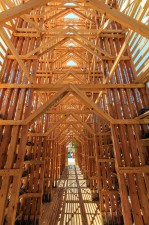 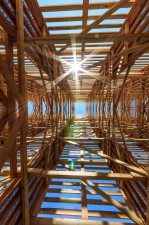 |
| Architectural art. Thumbnail images of Mine Pavilion from a larger collection by photographer Ryan Dravitz, from his blog entry at DenverUrbanism. |
Attendees of the gem and mineral shows in Denver, which wound down last month, might have noticed a curious structure in the parkway of Speer Boulevard at Larimer, just north of the Convention Center. Mine Pavilion is a site-specific architectural sculpture by art and architecture studio Pezo von Ellrichshausen, based in Concepción, Chile’s second largest city.
The work, which uses beetle-kill wood, was erected in conjunction with the second Biennial of the Americas, which bills itself as “an international festival of ideas, art, and culture.” Beyond that, people (pundits included) might have trouble explaining the event, but even detractors like Westword’s Michael Paglia praised the art choices (see “This year’s Biennial fizzled rather than sizzled”). Describing Mine Pavilion, Paglia wrote, “This multi-story wooden structure, set on a bed of rocks, manages to simultaneously refer to the state’s history and function as a non-objective sculpture.” Biennial co-curator Paul Anderson tells it this way:
To drivers on Speer Boulevard, it is a billboard. To pedestrians walking along Larimer, it is a tunnel. Its height and proportions make it a tower. Its suspended floor and intermediary site make it a bridge. Its beetle kill pine facade and structural detailing make it a mining building. The pavilion’s schizophrenia is subtle. Its diverse architectural genetics are integrated so coherently that at a glance, it appears to be a single, pure gesture. The project is also slyly contextual.
Every typological reference has defined the site at one time or another. Denver was a mining settlement in 1858, when General William Larimer staked a square mile claim on the very same piece of land. Gold panning prospectors gathered around Larimer, forming Denver City. Today, the tower is the elemental feature of the area.
Anderson also sees the structure as a bridge connecting the ivory tower of academia—the Auraria campus, west of Speer is home to three schools—with “the vibrant and fluid fabric of the city.”
Another bridge of sorts had its premier the week of the Denver gem and mineral shows. Formations, the first symphony by CU composer Jeffrey Nytch, spans time, space, intellect and emotions through its four movements: Orogenies, Rush!, Requiems, and Majesties. Commissioned by the Geological Society of America, based in Boulder, and the Boulder Philharmonic, which inaugurated the work, Nytch’s symphony celebrates the GSA’s 125th anniversary.
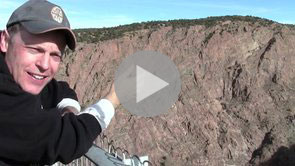 |
| Sight and sound. Composer and geologist Jeffrey Nytch takes you through the four movements of Symphony No. 1: Formations via video blog. |
The idea for the symphony was Nytch’s “crazy idea,” as he told the journal Nature. The composer, who also holds a degree in geology, heard about the GSA anniversary, and approached the Philharmonic. As Nytch put it, the commission became the perfect “keystone” event for the celebration.
The first movement (a term never more aptly applied), “Orogenies,” takes the listener through the foundation-laying (geological, musical) of Precambrian geology and three musical climaxes, portraying three mountain-building events, ending in an extended, quiet coda reflecting 500 million years of relative quiet. Being present for the premier, I found the movement to be plainly evocative, but it ended on an extremely tender note, with a musical ghost image that made for listener expectation regarding the second movement, “Rush!" Here fiddle tunes, rising and fizzling (Nytch’s term), recall the waves of prospectors, first in Pike’s Peak and later in Cripple Creek. We hear the miners’ pans against the whooshes (all the brass blown with open lips—you have to hear it!) depicting hydrothermic intrusions, the “geologic process that formed most of the mineral deposits in the region,” per Nytch. The movement closes with two violent events: the “thundering of the Cripple Creek Diatreme, an explosive volcano that created Colorado’s richest deposits of precious metals” and the crack of gunshots from Colorado’s labor wars in the mines. (A local historian told me that in Cripple Creek, the workers sabotaged the smelting operation by forcing the kiln to cool with ore still in it, thus turning the furnace into a monument to the rebelliousness of the workers.)
The third movement, “Requiems,” is an elegy to the Cretaceous, during which the tropical flora laid down their lives that we might enjoy ours, in a comfort supplied largely by their remains. It was the most compelling, musically and intellectually (to this erstwhile Christian), and evidently dearest to the composer. Some animated movement amongst the winds (measuring up favorably against the Benjamin Britten “Sea Interludes” from Peter Grimes, which began the program) captured the tranquility of forest and lagoon. A eerily vocalized trombone solo near the end at once soothed and quickened the heart. Movement 4, “Majesties,” closed the symphony, reprising themes from before, devoted to describing the formation of our Rocky Mountains. All in all, a thirty-minute homage to eons of events, and one deserving a wider audience.
GIA Sponsorship a First
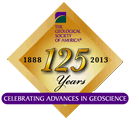 |
Don’t forget “the main event.” The Geological Society of America is holding its 125th Anniversary Annual Meeting and Expo in Denver, October 27–30, 2013. For the first time at a GSA meeting, GIA is sponsoring a topical session. “Gemological Research in the 21st Century: Characterizing Diamonds and other Gem Minerals,” featuring a powerhouse roster.
The abstracts are now online for Day 1 (Tuesday session #218) and Day 2 (Wednesday session #375, including a paper by Palagems Reflective Index contributor Elise Skalwold).
Scheduled for the session are James E. Shigley (GIA), Dona M. Dirlam (GIA), George R. Rossman (Caltech), George E. Harlow (American Museum of Natural History), William B. Simmons (University of New Orleans), Frank Hawthorne (University of Manitoba). The description of the session reads: Gemstones are the most recognized, sought after, and highly valued of all minerals. This session will focus on characterizing the properties of gems, documenting their conditions of formation, and improving the means of their identification. [back to top]
— End October Newsletter • Published 10/2/13 —
August 2013 Newsletter
 |
| Quite a collection. At the Houston Fine Mineral Show, April 2013. (From left) Dave Wilber, What's Hot in Tucson host. Jim Spann, half of the team behind the Gail and Jim mineral collection that was featured at Westward Look in 2009. (Gail took these photos at the Houston show.) Bill Larson, President of Pala International. Joel A. Bartsch is President and Curator of Gems and Minerals at the Houston Museum of Natural Science. (Photo: Will Larson) |
Shows and Conferences
- Bill Larson to Present at Dallas Symposium August 23–24, 2013
- Pala at Colorado Mineral & Fossil Show September 11–15, 2013
- Chowing Down in Changsha: Pala’s Will Larson Reports on the Inaugural Mineral and Gem Show
Pala International News
Mineral and Mineralogy News
Pala Presents
- Corundum from Prilep Dolomitic Marble (Macedonia)
A reprint by Miha Jeršek & Breda Mirtič
Recycle Bin
Shows and Conferences
Bill Larson to Present at Dallas Symposium
August 23–24, 2013
 |
The 3rd Annual Dallas Mineral Collecting Symposium is scheduled for August 23 and 24. The event kicks off with a Friday night cocktail party at the Perot Museum of Nature and Science.
The symposium itself takes place on Saturday at Southern Methodist University’s Cox School of Business. Pala International’s Bill Larson will speak on “40 Years at the Himalaya Mine.” The tentative list of speakers:
- The Pederneira Mine – Daniel Trinchillo
- Mining Malachite and Carrollite in the Congo – Brice Gobin
- 40 Years at the Himalaya Mine – Bill Larson
- Analytical Techniques on Earth and Mars – Dr. Robert Downs
- Mindat and Its Uses – Jolyon Ralph
- Treasures from my Collections, and Changes in Mineral Collecting over 60 Years – Dave Wilber
- Collecting the Best – Ikons and the Ikons Book Wayne Thompson
- Russian Gem Mines – Dr. Peter Lyckberg
 |
| Beryl on display at the Perot Museum of Nature and Science. (Photo: Mark Knight Photography) |
[back to top]
Pala at Colorado Mineral & Fossil Show
September 11–15, 2013
Pala International will be at the Colorado Mineral & Fossil Show.
- When: Sept. 11–15, 2013
- Where: Ramada Plaza Hotel (formerly Holiday Inn Denver–Central), 4849 Bannock St.
- Room 183
- Hours:
Wed.–Sat.: 10 a.m.– 6 p.m.
Sun.: 10 a.m.– 5 p.m.
We look forward to seeing our many friends there. For more information visit the show website.
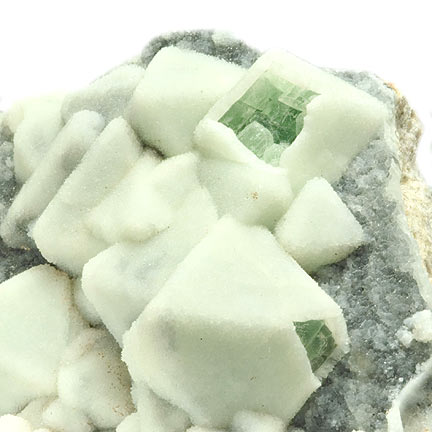 |
| Peek-a-boo. An unusual green fluorite with a white druzy quartz covering, in an octahedral crystal form. From Columbine, La Plata County, Colorado. It’s still available. (Photo: John McLean) |
Visit the Pala International Show Schedule for future events. [back to top]
Chowing Down in Changsha
Pala International’s Will Larson Reports on
the Inaugural Mineral and Gem Show
In May, Pala’s Bill and Will Larson attended the first Changsha Mineral and Gem Show in Hunan, China. In his report on the show, Will Larson states that about 1,200 dealers attended. The show organizers had had hoped for 100,000 attendees. “I’m quite sure the figures came in at substantially less,” Will writes, “but to me it was still a vast success.” After all, the show had been organized in only one year. Much of the show had a home-grown flavor. It was, Will writes, “almost as if the dealer was just showing his collection to the public,” meaning an inquiry as to price might be met with a reply of “not for sale.” Okay, so a little window shopping; there was more to choose from…
Read Will Larson’s full report here.
 |
| Please note that pitted items may contain stones. A typical restaurant-sized lazy Susan table, above, is loaded down with a huge assortment of mineral specimens arranged to resemble tasty dishes. Below, an actual label of a soup offering at the convention center. You can order your own online; just add duck. (Photos: Will Larson) |
 |
ICA held its Congress in conjunction with the Changha show and, as promised, speaker presentations are now available. [back to top]
Pala International News
Pala’s Featured Specimen: Scorodite on Quartz
When Spanish conquistadors penetrated into the interior of the land now called Mexico, they found a region rich in silver. In fact, the city of Zacatecas, in the southeast part of the state that today bears the same name, originally was called Minas de los Zacatecas. (Zacateca has its roots in a Spanish rendering of the region, taken from Nahuatl word for “reed,” “grass” or “straw”: zacatl.) The mines were so productive they were second only to those of Potosí, Bolivia. The immense amount of silver contributed to, and virtually created, the money economy of Europe at the time. In his 1988 book Indian Givers: How the Indians of the Americas Transformed the World, anthropologist Jack Weatherford, citing historian Fernand Braudel, wrote that in the first fifty years of the conquest (four years before the Spaniards found the riches of Zacatecas in 1546) already 16,000 tons of silver had passed into Seville’s port—about $10 billion in today’s market. Weatherford stated that Potosí “rivaled such Old World cities as London and Paris in size.” Zacatecas was second in size only to Mexico City, during New Spain’s colonial period. Much wealth left for Europe, but enough remained to allow Zacatecas to build its own fine examples of Spanish Baroque architecture. The city’s cathedral is remarkable for its integration of indigenous designs in the stonework of what otherwise is a 17th century church. The state of Zacatecas also is home to native architecture such as La Quemada (“the burned” city), referred to by one tourism site as “Pre-Colombian precious stones.”
Northeast of Zacatecas (the capital) is the municipality of Concepción del Oro, named due to the other precious metal found in the region—gold. The locality also is noted for varieties of quartz. Sometimes the quartz sports a little something extra, as in our featured mineral specimen.
 |
| Scorodite on quartz, 5.2 x 4.0 x 2.5 cm, from El Cobre Mine, Zacatecas, Mexico. Price available upon request. Click to enlarge. (Photo: Mia Dixon) |
This specimen displays a complex of quartz crystals topped by a single dipyrimidal crystal of scorodite, an ester of arsenic. The name comes from scorodion, Greek for “garlicy,” the odor released when the material is heated. (Don’t try this at home, kids…) The specimen hails from El Cobre Mine—Spanish for “copper.”
Interested? Select the inventory number above, call or email us to inquire. [back to top]
Mineral and Mineralogy News
Gem Shines in Leadville
National Mining Hall of Fame and Museum
 |
Like Zacatecas and Potosí, Leadville, Colorado, has its own silver mining story, beginning three centuries later, in the 1870s. The town was famously founded by Horace Austin Warner Tabor, whose tale of boom and bust was carried to the silver screen (the 1932 film à clef, Silver Dollar) and to opera stages from Central City to New York City (The Ballad of Baby Doe, 1956). While Tabor still had the means, he bankrolled Denver’s Tabor Block at 16th and Larimer and Tabor Grand Opera House at 16th and Curtis (both plowed under for an office building and shopping mall, respectively). He also built Leadville’s Tabor Opera House, which fortunately has escaped the wrecker’s ball. In 1882 that venue was graced with a lecture by Oscar Wilde. (The visit by Wilde opens the 1997 film Wilde; Santa Fe Opera currently has the world premier of Oscar on its boards.)
Paying its own homage to historical figures, in the field of mining itself, is Leadville’s National Mining Hall of Fame and Museum. Men and women, near and far, legendary and all but forgotten have a place here, from Horace “Haw” Tabor, naturally, and Augusta Louise Tabor, the “First Lady of Leadville”; to young Conrad Reed who played hooky from Sunday school one day in 1799 only to find a 17-lb. gold nugget while fishing in a North Carolina creek, thereby launching the country’s first gold rush; to Alfred Nobel, whose contribution to the field was, well, powerful.
 |
| Museum entrance. Even before entering the door the visitor is treated to mineral specimens, mining tools, and bronzes, both miniature and life-size, such as the figure at top, by sculptor Lori Kostur, of a hatted miner wielding a single jack hammer towards the drill held in the direction of the viewer (click to enlarge). (Photo courtesy National Mining Hall of Fame and Museum) |
Also inducted into the Hall of Fame is Herbert Hoover, who, with twenty years behind him as a mining engineer, became one of the most prominent mining consultants in the world. He and his wife, fellow inductee Lou Henry Hoover, translated for the first time into English Georgius Agricola’s monumental De Re Metallica (On the Nature of Metals, 1556). Its original roughly 500 pages were filled with hundreds of neologisms—all in Latin, used to describe the techniques of Medieval German mining and milling. (By comparison, Shakespeare, in his complete works, invented between 500 and 2,000 new expressions.) Fortunately for the Hoovers, the future First Lady was a linguist. Nevertheless, the project took five years, all the couple’s free time, and $20,000 of their savings. It was published in 1912 to great acclaim.
 |
| Red carpet. The royal treatment continues in a hall of several mineral collections. The large case at left is the collection of Bolivian tin miner Victor J. Hampton. The cases at the right house hundreds of mineral specimens. (Photo courtesy National Mining Hall of Fame and Museum) |
This year’s five inductees will be honored—posthumously, save for one, Patrick H. O’Neill, who is just shy of the century mark—during a banquet on Saturday, September 14 at Denver’s Brown Palace Hotel (its triangular edifice now in the process of being lovingly restored, but thankfully without a shred of scaffolding). All are invited to attend.
 |
| Red hot. Horsepower was essential in the mines. A metalsmith (sculpted by Gary Prazen) prepares to forge a heated horseshoe in this blacksmith shop simulation. (Photo courtesy National Mining Hall of Fame and Museum) |
Of course, there’s a second component to Leadville’s little jewel: the National Mining Museum. It is beautifully housed in what was once the local high school (and junior high), built in 1899. But where to begin? Exhibits include bronze and metal sculptures, a model railroad of a mountain mining town, above- and below-ground dioramas, simulated hard rock and coal mines, a prospector’s cave, as well as many, many specimens of gold, crystals, ores and minerals. And for good measure, a collection of German ceremonial miner’s axes (part of any self-respecting miners’ Berghabit). The status of miners was different, it seems, than it is today. “Second only to clergy,” we were told, by Dr. Vince Matthews, Interim Director of the National Mining Hall of Fame and Museum.
 |
| Gussied up. Although of Medieval origin, the tradition of miners’ parade uniforms survives to this day. The ceremonial ax, as noted by the University of Oxford’s Pitt Rivers Museum, is not a working tool; its distinguishing design serves to identify the bearer. Above, a mining captain (Oberberghauptmann) holds his Bergbarte in an illustration from a 1831 work by G. E. Rost. The Peschel Collection, one of the most comprehensive arrays of such axes, from the 12th through 18th centuries, is on display at the National Mining Hall of Fame and Museum. (Click to enlarge) |
 |
| Missing. Some time between last December 29 and February 8, the above covellite specimen was stolen from the National Mining Hall of Fame and Museum. The thief replaced the mineral with an impostor, hoping it would be overlooked. Word of the theft was broadcast prior to the Tucson shows, but it still has not been recovered. The specimen was collected by Orville Kager, Assistant Foreman, in 1950 and was from the North Bennet Vein of the historic underground Leonard Mine in Butte, Montana. The missing mineral specimen was a part of the Anaconda Collection given to the museum by Arco Coal Company shortly after the museum was established. As can be seen from the above photo, it is rare and of unusually fine quality. If you have information, please contact the museum or call 719.486.1229. (Photo: Christian Mavris via Mindat.org) |
[back to top]
Pala Presents
Corundum from Prilep Dolomitic Marble (Macedonia)
By Miha Jeršek & Breda Mirtič
With Pala Presents, we offer selections from the library of Pala International’s Bill Larson, who will share with us some of the wealth of information in the realm of minerals and mineralogy.
With this edition of our newsletter we are pleased to offer a reprint of an study by Slovenian scholars Miha Jeršek & Breda Mirtič of corundum from the dolomitic marble of Prilep in central southern Macedonia, part of the metamorphic rocks of the Pelagonian Massif, which stretches from the capital Skopje southeast to the Aegean Sea. The authors describe corundum from Prilep marble in a wide variety of forms, some of them for the first time. One such morphology is diaspore intergrowth. The light reflected from diaspore lamellae, described as a “silverly-white glittering,” is a phenomenon “unique in the world of gemstones,” according to the authors, “and we have named it “diasporescence.”
Read “Corundum from Prilep Dolomitic Marble (Macedonia)” here.
 |
| Spectral. Characteristically pink and red coloured corundum crystals. Prismatic crystal on the right is blue coloured and is rarely found in Prilep marble. Its height is 3.0 cm. |
[back to top]
Recycle Bin
Below are recent items from our sibling publication, Palagems Reflective Index, that will be of interest to mineralophiles.
How I Spent My Summer Vacation: Larson @ Harvard
Last month, Pala International’s Bill Larson appraised the gemstone collection at the Mineralogical and Geological Museum at Harvard University. Bill was chosen by the museum’s associate curator, Dr. Raquel Alonso-Perez, to appraise the collection’s 1,200 pieces. The first day just over 500 pieces had been examined with two more full days to follow. “Raquel couldn’t believe how focused I was when looking at the gems,” Bill told us. Many special notes were documented. Bill reported that a good feeling emanated from all those involved.
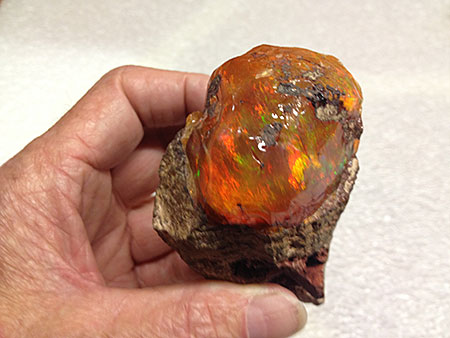 |
| “For those who do not know,” Bill Larson explains, “fine Mexican opal lasts!” This opal nodule, in rhyolite matrix, contains goethite inclusions. From the Iris Mine, Hacienda Esperanza, Queretaro, Mexico. Gift of James A. Garland, 1892. (Photo: Bill Larson) |
“They did the heavy lifting—organizing the list (name, carat weight, locality, and other details),” Bill told us. “I just have to appraise the wholesale value of each piece, providing particular notes on what should be retained and displayed, and what is not up to standard.” Bill said that going through and handling each gem, one by one, was a treat. And there often was a lot of history behind a given stone. “I was seeing pieces from George F. Kunz and Fredrick Canfield from the early 20th century. And later on, pieces from Fred Pough, Martin Ehrmann and special Larson friend John Sinkankas.”
Thus begins Bill’s report on his time at Harvard. Read the full report here.
And for more on Harvard’s mineral specimens, hosted by Dr. Raquel Alonso-Perez, see “Geology rocks at the Harvard Museum Natural History,” from the Taunton Daily Gazette. We’re told that Dr. Alonzo-Perez will be a presenter at the 2014 Sinkankas Symposium, the theme of which will be Peridot and a few rare green gemstones. [back to top]
Blue Ice: Christian Klepp Goes Glacial
We recently received some images of gem-like ice, recalling the “jade icebergs” we pointed to four years ago. These photographs, by German geoscientist and photographer Dr. Christian Klepp, are of highly pressurized glacial ice, containing almost no air bubbles. The ice absorbs all but the shortest blue fraction, putting the aquamarine in aquamarine. The images are from Svinafellsjökull glacier, Skaftafell, Iceland. Get all the science behind the phenomenon in the links below.
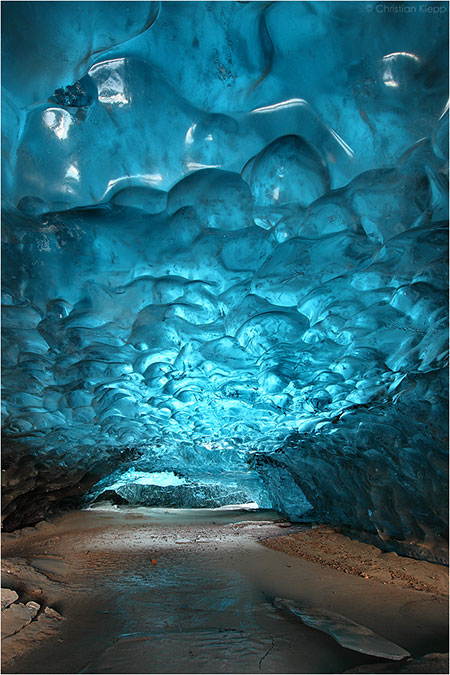 |
| Entering the Enchanted Realm. This tunnel of ice from thousand-year-old snow is 164 feet long, 33 feet wide, and 6 feet tall. And it’s on the move—about a meter a day. All the details are here. (Photo © Dr. Christian Klepp) |
Dr. Klepp has published a book, in both English and German, LichtJahre [LightYears] – Where Geoscience Meets Art, available. The book covers quite a bit of ground, with images from Iceland to Turkey to New Zealand and more.
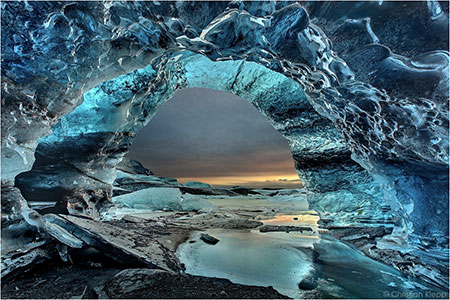 |
| The Crystal Grotto. This is an ice cave in Svinafellsjökull glacier where the outside temperature remains below 17°F for long periods. You will want to appreciate the Escher-like quality of the larger image (and the technical detail) here. (Photo © Dr. Christian Klepp) |
For more icy aqua, see the North Baikal images of Bratsk-based photographer Alexey Trofimov (El Barto), beginning here. [back to top]
Decoding the Cookbook
AMNH’s George Harlow works on the recipe for a “crazy rock”
In late 2010, we pointed to a two-part overview of an expedition by Dr. George Harlow and colleagues to research the origins of jade in Guatemala. Last week, Dr. Harlow was quoted in the New York Times regarding the same research, following recent articles in Geology and Earth and Planetary Science Letters, coauthored by Harlow. In the Times, geologists are likened to geological chefs, sampling the earth’s creations, attempting to re-create the recipe. These scientists have concluded that jade has oceanic origins, whereas rubies, for instance, formed in mountains, even if those mountains have long been eroded. (Brings to mind a ’67 ditty by Brit popster Donovan Leitch.)
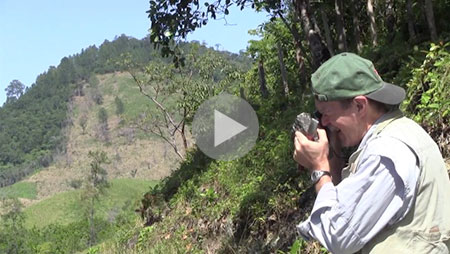 |
| Dr. George Harlow examines a specimen in a still from “Solving a Geological Puzzle in Guatemala." |
[back to top]
— End August Newsletter • Published 8/1/13 —